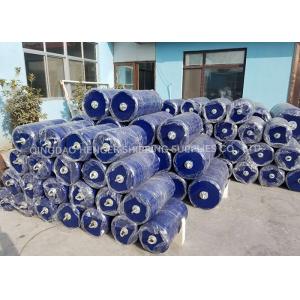

Add to Cart
Intoduction
When a ship is anchored at a dock or a ship is anchored to a ship, the huge hull will produce a very large impact force due to collision; when a ship is anchored at a dock, due to the combined effect of the sea wind, waves and the rise and fall of the water level, the ship will collide with the dock, compress and rub against it, producing a three-dimensional force with an extremely complex mechanism and a long duration. These forces often cause damage to the quay structure and the ship. Therefore, the selection of an appropriate anti-collision buffer to absorb the kinetic energy of the collision and reduce the mutual reaction force between the ship and the quay or between the ship and the vessel is undoubtedly very important for the protection of both the quay and the ship. The globalization of the economy and logistics has promoted the development of global maritime shipping and continental maritime and land transport, making the size of maritime transport vessels ever larger.
Large ships with large tonnage, large draft, large momentum and
additional water mass are also large (when the ship moves in the
water, the water around the ship also moves with it, when the ship
docks on the pier, this part of the water body moves with the ship
and generates impact energy on the pier through the ship, the mass
of this part of the water body is called additional water mass),
the combined effect of the two is enormous impact energy when
docking, which makes the offshore port This has placed higher
design and operational demands on docks in offshore ports, making
the development of dock structures towards deeper waters and larger
scale an irreversible inevitable trend. In parallel with the trend
towards berth development, the growth of larger ships has also
created new requirements for additional berth equipment and
facilities, such as the need for larger size and capacity of
loading and unloading equipment to accommodate the increased scale
of ships and the need for fenders that absorb more impact energy to
safely moor large capacity ships.
Spray polyurea elastomer technology has many advantages.
1. Catalyst-free, highly reactive and fast curing, it can be
sprayed on any inclined, curved or vertical surface without
sagging.
2. It is not sensitive to humidity and temperature and is not
affected by the temperature of the component or environment or the
humidity of the component or air, and can be applied at
temperatures from -40 to 50°C.
3. It is a two-component paint with 100% solid content, contains no
volatile organic solvent (VOC), environmentally friendly, the
evaporation of the solvent does not cause the construction site to
be filled with the odor of the evaporated solvent, can achieve
hygienic construction and non-hazardous construction.
4. The manufacturing process can be carried out by thermal spraying
or cracking, and the thickness of an application can range from a
few hundred um to a few cm, overcoming the shortcomings of the
traditional environmentally friendly coating process, which
requires several applications to achieve the designed coating
thickness.
5. It has excellent physical and chemical properties, high tensile
strength, elasticity and elongation at break, abrasion resistance,
anti-slip properties, solvent and salt spray aging properties,
resistance to seawater and general solvent corrosion. Hardness can
be adjusted at will and the feel ranges from soft rubber to hard
elastomer. No chalking, cracking or peeling in long-term outdoor
use.
.
6. Good thermal stability and good low temperature resistance, can
operate at 120°C for a long time, can withstand 350°C instantaneous
thermal shock.
7. Good reproducibility of substrate shape, continuous and dense
coating, no joints, no bubbles and holes, beautiful and durable. It
is possible to add various pigments, short glass fibers and other
fillers to make different colors and performance requirements of
coating products, to meet the customer's needs for color and other
performance aspects.
